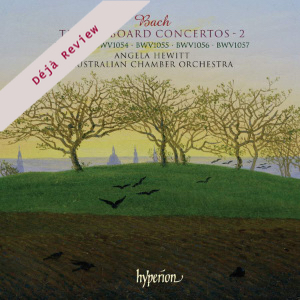
Déjà Review: this review was first published in July 2005 and the recording is still available.
Johann Sebastian Bach (1685-1750)
The Keyboard Concertos – 2
Keyboard Concerto no. 2 in E BWV1053
Keyboard Concerto no. 3 in D BWV1054
Keyboard Concerto no. 4 in A BWV1055
Keyboard Concerto no. 5 in F minor BWV1056
Keyboard Concerto no. 6 in F BWV1057
Angela Hewitt (piano)
Alison Mitchell, Emma Sholl (flutes: no. 6)
Australian Chamber Orchestra/Richard Tognetti
rec. 2005, Verbrugghen Hall, Sydney Conservatorium of Music, Australia
Hyperion CDA67308 [75]
The first movement of concerto no. 4 emerges here as the perfect counterpart to an eighteenth-century painting of a family music party, with each member smilingly at harmony with the next; such is the sense of pure joy which the performance exudes, the busy counterpoint far from a cerebral exercise, but rather a conversational interplay of ideas.
I chose the first movement of the first piece on the disc (they are played in the order 4, 3, 2, 5, 6) simply because this was my first impression; but in truth I think that any of the swifter movements would have told the same story. It is no doubt Angela Hewitt’s ability to make Bach a living person rather than a monument which has made her Hyperion series such a success.
I have a query, though, regarding the slow movements. The Australian Chamber Orchestra is a very fine group and it has clearly taken to heart the lessons of the “authenticists”. This means that in the slow movements we get an un-vibratoed sound with an expressive bulge on long notes, but with the notes kept separate. Long legato phrases are “out”. With some slow movements this is more of an issue than with others. I didn’t bring up this question when reviewing volume 1 because none of the slow movements there seemed of a nature to be affected by it. Nor is that of no. 6 here – if you don’t know these concertos, you will be surprised to find that this one is a version of the 4th Brandenburg Concerto – and the sepulchral sounds which open and close that of no. 3 are truly imaginative. But in that of no. 4, and in the “Siciliano” of no. 2, it is somewhat strange to find the piano spinning long legato lines while the strings chop the same phrases into small units. Mind you, JSB himself might have been intrigued by the paradox that the strings, which can play long “vocal” legato lines, don’t do so while the piano which theoretically can only hint at them, does so. But I think this paradox is more illuminating when the harpsichord is used as the solo instrument, since only by the purest trickery can it even hint at “vocal” legato. When the piano is the solo instrument, I suggest it may be better to integrate rather than contrast the expressive styles.
Still, this is more of a talking point than a criticism, and you may not agree anyway. What is in no doubt is that this is a Bach record to cherish. Recommended in particular to those who usually find this composer rather forbidding in all his contrapuntal ingenuity.
This is also a record that reinforces the image of Hyperion as a company of music-lovers which makes records for music-lovers. What a tragedy it would be if as a result of their ill-advised court case all this activity on behalf of music were to disappear, or to be drastically curtailed. So just a plea to readers: if a new Hyperion issue sounds attractive to you, do put it on the very top of your shopping-list. Hyperion needs its customers’ support at the moment, and music-lovers need Hyperion to continue.
Christopher Howell
Help us financially by purchasing from




















